Related Research Articles
Statistical geography is the study and practice of collecting, analysing and presenting data that has a geographic or areal dimension, such as census or demographics data. It uses techniques from spatial analysis, but also encompasses geographical activities such as the defining and naming of geographical regions for statistical purposes. For example, for the purposes of statistical geography, the Australian Bureau of Statistics uses the Australian Standard Geographical Classification, a hierarchical regionalisation that divides Australia up into states and territories, then statistical divisions, statistical subdivisions, statistical local areas, and finally census collection districts.
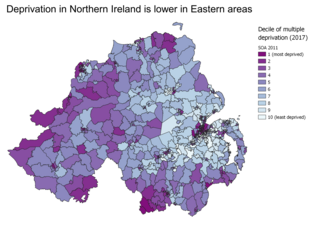
A deprivation index or poverty index is a data set to measure relative deprivation of small areas. Such indices are used in spatial epidemiology to identify socio-economic confounding.
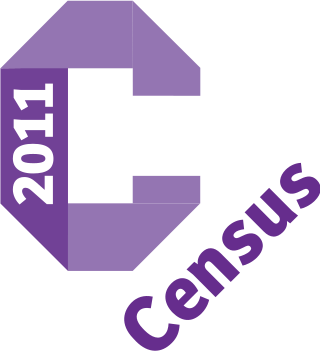
A census of the population of the United Kingdom is taken every ten years. The 2011 census was held in all counties of the UK on 27 March 2011. It was the first UK census which could be completed online via the Internet. The Office for National Statistics (ONS) is responsible for the census in England and Wales, the General Register Office for Scotland (GROS) is responsible for the census in Scotland, and the Northern Ireland Statistics and Research Agency (NISRA) is responsible for the census in Northern Ireland.

Crooklands is a hamlet in Westmorland and Furness, Cumbria, England, 4.5 miles (7.2 km) south of Kendal on the A65 road and the Lancaster Canal. Historically part of Westmorland, it is in the parish of Preston Richard but adjacent to Preston Patrick to the south east, the boundary roughly following Peasey Beck. The adjacent showfield of the Westmorland County Agricultural Society is the venue of the annual Westmorland County Show, Country Fest and various other events.
The Unique Property Reference Number (UPRN) is a unique number for every addressable location—e.g., a building, a bus stop, a post box, a feature in the landscape, or a defibrillator—in Great Britain. Over 42 million locations have UPRNs, which can be found in Ordnance Survey's AddressBase databases.
The ONS Postcode Directory (ONSPD) relates both current and terminated postcodes in the United Kingdom to a range of current statutory administrative, electoral, health and other area geographies. It also links postcodes to pre-2002 health areas, 1991 Census enumeration districts for England and Wales, 2001 Census Output Areas (OA) and Super Output Areas (SOA) for England and Wales, 2001 Census OAs and SOAs for Northern Ireland and 2001 Census OAs and Data Zones (DZ) for Scotland. It helps support the production of area based statistics from postcoded data.
The Index of Place Names (IPN) in Great Britain is published by the Office for National Statistics.

Alexandra Ward is a ward in the central area of Ipswich, Suffolk, England. It returns three councillors to Ipswich Borough Council.

Gainsborough Ward is a ward in the South East Area of Ipswich, Suffolk, England. It returns three councillors to Ipswich Borough Council.
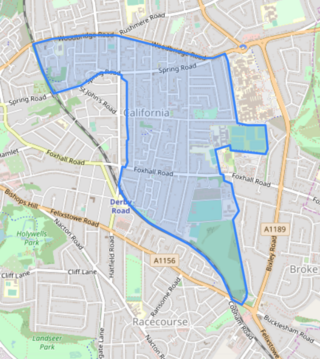
St John's Ward is a ward in the North East Area of Ipswich, Suffolk, England. It returns three councillors to Ipswich Borough Council.

Bixley Ward is a ward in the north east area of Ipswich, Suffolk, England. It returns three councillors to Ipswich Borough Council.
The South West Area, Ipswich is one of five administrative areas in Ipswich, through which Ipswich Borough Council divides its spending and enables feedback from local residents, businesses and community groups.
The Central Area, Ipswich is one of five administrative areas in Ipswich, through which Ipswich Borough Council divides its spending and enables feedback from local residents, businesses and community groups.
The North East Area, Ipswich is one of five administrative areas in Ipswich, through which Ipswich Borough Council divides its spending and enables feedback from local residents, businesses and community groups.
The North West Area, Ipswich is one of five administrative areas in Ipswich, through which Ipswich Borough Council divides its spending and enables feedback from local residents, businesses and community groups.
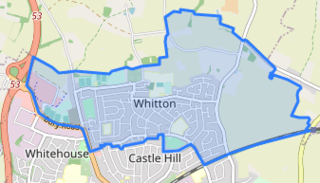
Whitton Ward is a ward in the North West Area of Ipswich, Suffolk, England. It returns three councillors to Ipswich Borough Council.
Sprites Ward is a ward in the South West Area of Ipswich, Suffolk, England. It returns three councillors to Ipswich Borough Council.
Stoke Park Ward is a ward in the South West Area of Ipswich, Suffolk, England. It returns three councillors to Ipswich Borough Council.
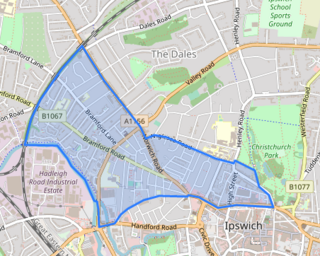
Westgate Ward is a ward in the central Area of Ipswich, Suffolk, England. It returns three councillors to Ipswich Borough Council.
References
- ↑ "New Geography Codes and Naming Policy implemented 1 January 2011". Office for National Statistics. Archived from the original on 11 October 2016. Retrieved 1 June 2011.
- ↑ "GSS Coding and Naming – Frequently Asked Questions (FAQ)" (PDF). Office for National Statistics. Retrieved 1 August 2012.
- ↑ "Register of Geographic Codes (RGC)". Coding and Naming for Statistical Geographies. ONS. Retrieved 4 September 2011.
- ↑ "ONS Geography Linked Data". Coding and Naming for Statistical Geographies. ONS. Retrieved 17 June 2017.
- ↑ "Code History Database (December 2022) for the United Kingdom". ONS. Retrieved 31 March 2023.
- ↑ "House of Commons Library MSOA Names". House of Commons Library. Retrieved 23 January 2025.
- ↑ "Output Areas". ONS.
- ↑ "Super Output Areas". ONS.
- ↑ Mapit https://mapit.mysociety.org/area/34764.html
- ↑ Mapit https://mapit.mysociety.org/area/70445.html
- ↑ "Census 2021 geographies". Office for National Statistics. Retrieved 2023-03-31.